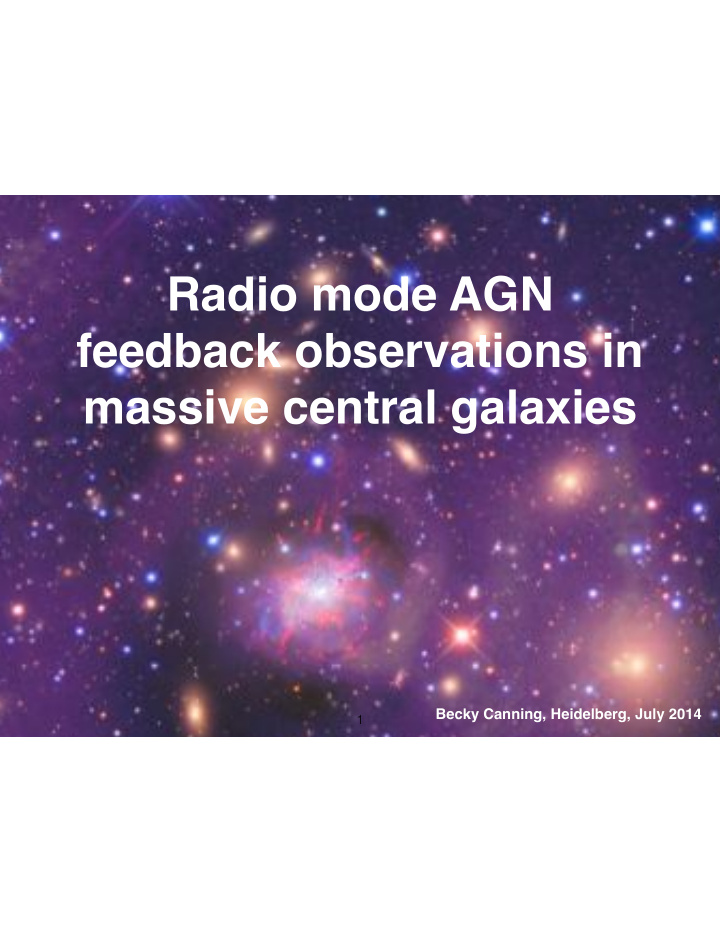



Radio mode AGN feedback observations in massive central galaxies Becky Canning, Heidelberg, July 2014 1
Multiphase media in X-ray bright galaxies Low redshift, X-ray bright, massive (central) galaxies ! Masses ~10 11 -10 12 solar masses Single SSP models suggest ages of ~ 10 billion years SFRs typically <0.1-1 solar mass per year (often upper limits from Galex - without correction for old stellar populations) No recent wet mergers 2
Multiphase media in X-ray bright galaxies Low redshift, X-ray bright, massive (central) galaxies ! Masses ~10 11 -10 12 solar masses Single SSP models suggest ages of ~ 10 billion years SFRs typically <1 solar mass per year (often upper limits from Galex - without correction for old stellar populations) Edge et al. 2001 No recent wet mergers 3
Multiphase media in X-ray bright galaxies Low redshift, X-ray bright, massive (central) galaxies What is the gases relation to ! ! Masses ~10 11 -10 12 solar AGN feedback? ! masses ! Single SSP models What is the origin of the gas? ! suggest ages of ~ 10 ! billion years Why isn’t it forming stars? SFRs typically <1 solar mass per year (often upper limits from Galex - without correction for old stellar populations) Edge et al. 2001 No recent wet mergers 4
Combine: HST optical/UV Abell 3581 ! JVLA and GMRT radio data z=0.0218 (95 Mpc) Chandra X-ray data SOAR optical imaging VIMOS spectroscopy Canning et al. 2013 5
Cool-core group - some heating is required ! 50’’ ~ 20 kpc Chandra X-ray 6
L X in the core ~ P cav in inner bubbles ! 2.1x10 42 ergs -1 ~ 2.2x10 42 ergs -1 Multiple bubbles - AGN timescales Duty cycles - high (70% to 100%) Birzan et al. 2004, Rafferty et al. 2006 ! Dunn et al. 2006 JVLA 1.4 GHz Chandra X-ray 7
~10 8 solar masses of gas H alpha ~10 6 solar masses of dust Dust 8
How can radio mode feedback affect galaxy evolution Quiescence: Keeping hot gas hot ! But cool and cold gas are observed in massive X-ray bright galaxies. ! Argue here that this gas originates from the hot gas and is heated/redistributed in the galaxy by RM AGN feedback. So RM feedback also important for ‘quenching’ (preventing cool/cold gas from forming stars). 9
JVLA 1.4 GHz 10
GMRT 600 MHz JVLA 1.4 GHz 11
H alpha GMRT 600 MHz JVLA 1.4 GHz 12
H alpha JVLA 1.4 GHz Chandra X-ray 13
Velocities in the cool gas Cool gas encases inner bubbles ! Smooth line-of-sight velocities Canning et al. 2013 14
Velocities in the cool gas High velocities observed near base of bubble ! AGN bubbles (and maybe jet) displacing and redistributing the cool and cold gas ! No SF observed in filaments ~0.2 solar masses per year in core Canning et al. 2013 15
Velocities in the cool gas High velocities observed near base of bubble Early science ALMA ! AGN bubbles (and maybe jet) results show outflow of displacing and redistributing ~600 km s-1 in very the cool and cold gas cold gas ! McNamara et al. 2013, Russell et al. 2013 No SF observed ~0.2 solar masses per year Canning et al. 2013 16
17
H alpha emission (6/8) 8 nearby brightest group galaxies with similar SFR, stellar masses and halo masses. Werner et al. 2014 18
[C II] emission (6/8) Cold gas morphologies and kinematics follow ionised gas Cold phase embedded in the ionised phase No H alpha = No extended cold gas Werner et al. 2014 19
0.5 kpc NGC 4636 X-ray pressure NGC 5813 0.5 kpc 1 kpc NGC 5044 NGC 4636 2 kpc Pressure Pressure Pressure Pressure 0.0004 0.0006 0.0008 0.001 0.00120.0014 0.0006 0.001 0.0014 5E-05 0.00015 0.00025 2 kpc NGC 5846 5E-05 0.00015 0.00025 keV cm -3 (l/20kpc) -1/2 Cold gas rich Pressure Werner et al. 2014 0.0008 0.0012 0.0016 0.002 0.0024 20
X-ray pressure Cold gas poor 2 kpc N G C 1 3 9 9 1 kpc NGC 4472 P r e s s u r e Pressure 0.002 0.006 0.01 0.0015 0.003 0.0045 0.006 keV cm -3 (l/20kpc) -1/2 Werner et al. 2014 21
Cold gas and hot gas Including 3 additional relaxed GEs Cold gas poor Outside of the innermost core, the entropy of systems containing cold Cold gas rich gas is lower Werner et al. 2012, 2014 22
Cold gas and hot gas The Field stability parameter, defined as ! Cold gas poor ! is the ratio of the conductive heating to the radiative cooling rate. Cold gas rich There is a dichotomy with the cold- gas-rich system remaining unstable out to relatively large radii. Werner et al. 2014 23
Jet powers and cold gas Cold gas poor Power input (measured from X- ray cavities) to ICM from radio mode feedback does not increase with amount Cold gas rich of cold gas Werner et al. 2014 24
Jet powers and cold gas Small jet power, many X-ray cavities and disturbed morphology, ! plenty of cold gas Large jet power, no cold gas, ! relaxed X-ray Werner et al. 2014 25
A cycle or end state? • High pressure X-ray gas powers persistent strong jets • Cool and cold gas destroyed • Jets propagate farther ! ! • AGN outbursts less steady - clumpy cold gas? • Interact with surrounding high density cool and cold gas
Summary: ! Cool and cold gas can be plentiful in X-ray bright massive galaxies but not necessarily in all. ! The gas likely originates from cooling of the hot ISM ! We identify two states: 1. Relaxed, dynamically stable ETGs cooling from the hot phase is not detected 2. Disturbed massive X-ray bright galaxies are often cold gas rich ! Radio mode feedback can couple to both hot and cold gas in massive galaxies in order to ‘quench’ the SF 27
Recommend
More recommend